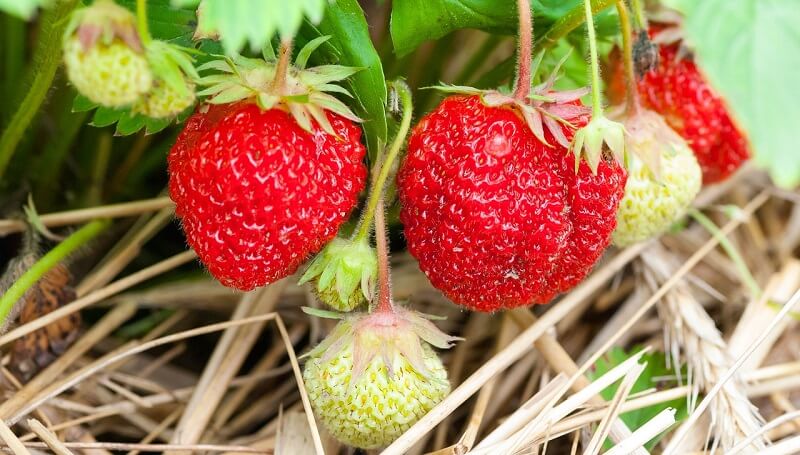
Imagine biting into a juicy, red strawberry, its sweetness bursting in your mouth. Now, picture reaching up to pluck that strawberry from a towering tree. Sounds a little strange, doesn't it? Let's dive into the fascinating world of strawberries and uncover the truth about where these delicious fruits truly come from and why we don't find strawberries hanging from branches.
Are Strawberries Actually Grown on Trees? The Truth Revealed
The short answer is a resoundingno, strawberries do not grow on trees. Strawberries are classified asaggregate accessory fruits, which are grown on low-lying plants. These plants, known scientifically as Fragaria, are typically found sprawling close to the ground, not reaching towards the sky like arboreal giants. Understanding this fundamental aspect of strawberry botany is key to appreciating their growth cycle and cultivation methods.
The strawberry plant itself is a relatively small, herbaceous perennial. This means that it lives for more than two years, and it has non-woody stems. It reproduces primarily through runners, also known as stolons – horizontal stems that creep along the soil surface. These runners send down roots and develop into new, independent strawberry plants, creating a colony of strawberry goodness.
Because of its low-lying nature and reproduction through runners, it is not feasible for strawberries to grow on trees. They lack the structural support and necessary adaptations for survival in an arboreal environment.
Understanding Strawberry Plants and Their Growing Habits
To better understand why strawberries don't grow on trees, it's important to delve into their growing habits. The strawberry plant is a marvel of nature, perfectly adapted to its terrestrial environment.
The Strawberry Plant's Root System
The strawberry plant has a relatively shallow root system. This means that its roots don't penetrate very deep into the soil. Instead, they spread out horizontally, allowing the plant to efficiently absorb nutrients and water from the topsoil. This shallow root system is ideal for a ground-dwelling plant, but it would be insufficient to support the plant's growth on a tree. Trees, conversely, have deep and extensive root systems to anchor them to the ground and supply them with resources from deeper soil layers.
Strawberry Plant Reproduction
As mentioned earlier, strawberries primarily reproduce through runners. These runners allow the plant to quickly colonize an area, spreading its genetic material and establishing new plants. This method of reproduction is highly effective for a ground-dwelling plant, as it allows it to quickly take advantage of available resources. However, runners would be ineffective in a tree environment, as they would need to be suspended in the air to reach new locations.
Sunlight Requirements for Strawberry Growth
Strawberries require ample sunlight to thrive. They need at least six to eight hours of direct sunlight per day to produce sweet, juicy berries. This requirement is easily met when the plants are growing on the ground, where they have unobstructed access to sunlight. In a tree environment, however, the strawberry plants would be shaded by the tree's canopy, significantly reducing the amount of sunlight they receive. This lack of sunlight would hinder their growth and reduce the yield of berries.
Exploring the Environmental Needs of Strawberries: Why Trees Aren't Suitable
Strawberries are relatively adaptable plants, but they do have specific environmental needs that must be met for them to thrive. These needs include adequate moisture, well-drained soil, and protection from extreme temperatures. Let's examine how these needs are typically met in a ground-based environment and why they would be difficult to meet in a tree environment.
Strawberries prefer consistently moist but not waterlogged soil. This balance is easily achieved on the ground, where the soil can retain moisture without becoming saturated. In a tree environment, it would be difficult to maintain this balance. The soil in a tree's canopy tends to dry out quickly, especially during hot weather. Furthermore, it would be challenging to ensure that the strawberry plants receive adequate drainage, which is essential for preventing root rot. Root rot is a common disease that can kill strawberry plants if their roots are constantly submerged in water.
Strawberries are also susceptible to damage from extreme temperatures. They can tolerate cold temperatures down to about 20 degrees Fahrenheit, but they need protection from frost. On the ground, the soil acts as an insulator, protecting the strawberry plants from extreme temperature fluctuations. In a tree environment, the strawberry plants would be exposed to the full force of the elements, making them more vulnerable to frost damage.
Do other Fruits Grow on Trees like Strawberries?
While strawberries are ground fruits, some fruits are grown on trees. However, most of these fruits such as apples, bananas, oranges, and cherries have a different growing habit and are not even related to strawberries at all. Each fruit has its own adaptation that makes it thrive best in the environment it is in.
So, while the image of strawberries dangling from trees might be a fun thought experiment, the reality is that these delicious fruits are firmly rooted in the ground, where they can best thrive and provide us with their sweet, juicy goodness. Next time you enjoy a bowl of strawberries, remember the complex interplay of factors that contribute to their growth and appreciate the ingenuity of nature in creating such a delightful fruit.